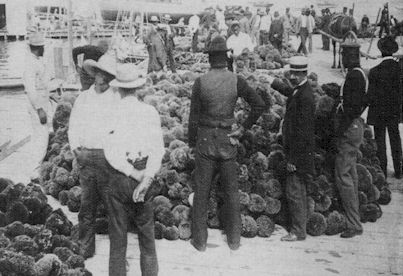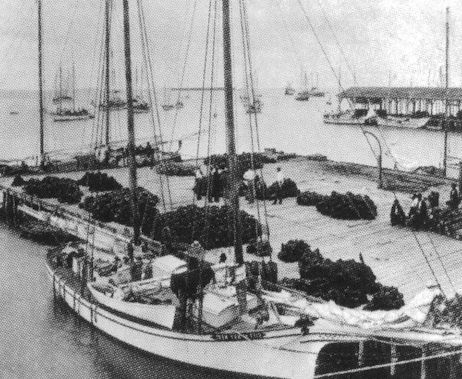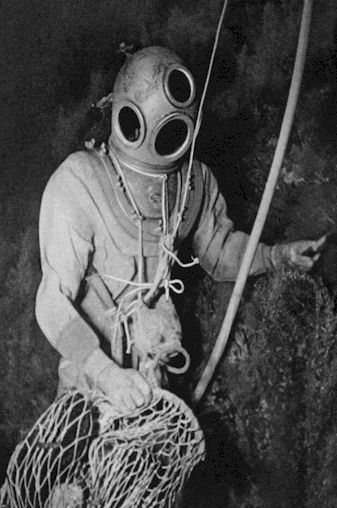
Sponge fishing in Key West and Tarpon Springs
Copyright © by Sandra Hendrikse and André Merks
Key West
The history of sponge fishing in America begins, almost coincidentally, back in the early 19th century. A small sponge industry began with the settlement of Key West. Native Key West fishermen found sponges washed on the shores after storms. These sponges became the reason for the formation of a small fleet of "Hook Boats".
| They were called this because they used a log pole with a three or four –pronged rake on the end to hook the sponges (hooking method) from shallow waters. These sponges were used only for local domestic use until the year 1849 when a sample shipment of sponges was sent to New York and found a ready market. Immediate expansion of the sponge industry began and, by 1890, Key West held almost an absolute monopoly of the sponge trade in the United States. The sponge fleet of Key West contains at that time 350 vessels. More than 1400 men where employed in the sponge industry. Nearly all of the sponges were collected from shallow water. |  |
|
|
As the sponge industry expanded in Key West, the spongers went out in quest of other sponge fields. They discovered that further north up the Gulf of Mexico were beds loaded with sponges of different varieties. During the Spanish – American war (1898), because of their fear of Spanish warships, the entire Key West sponge fleet ("hookers") put into the area of Tarpon Springs to sell their sponge cargo. |
As the Key West sponging grounds were by this time becoming depleted, Tarpon Springs quickly took over the lead in sponge production.
Tarpon Springs capital of the Greek sponge divers
By the time a few fishermen began harvesting sponges in the Florida Keys in the late 1800’s, The Greeks had been harvesting sponges in the eastern Mediterranean Sea for centuries (see Sponge diving in Greece). A diving suit with an air hose (Skafandro suit) had been introduced in Greece in 1865, allowing divers to harvest sponges from deep waters. For some reason the diving suit had not come to America.
| At the end of the 19th century the sponge fishing industry, and later sponge diving industry, was established due to John Corcosis and John Cheyney. Corcosis, a born Greek, came to New York in 1895 to work in the sponge trade. There he met John Cheyney, one of the early settlers in Tarpon Springs who sent out the first "hooker boat" from Tarpon Springs. |  |
It was Cocoris who insisted on bringing Greek divers to carry on the sponge industry in Tarpon Springs on a larger scale. In 1905 the first colony of Greek sponge divers had been established at Tarpon Springs. At that time, the sponge diving industry in Greece had growth to her maximum and large groups of divers where seeking for opportunities in other parts of the world. Tarpon Springs became one of them. The Greek divers brought with them the technology of hard-hat diving, plans of the boats in the Mediterranean and other paraphernalia.
 |
Diving is much more remunerative than hooking sponge and this quickly became the accepted method of collecting sponges. After the first dive, wich took place in june 1905 a large group of Greek immigrants from the Greek Islands of Aegina, Halki, Kalymnos and Symi, settled in Tarpon Springs. By the end of 1906, 1500 Greek sponge fishers, divers and workers had arrived. Tarpon Springs prospered through the 1920s and 1930s. Around this period, the sponge fleet averaged around 200 vessels. By 1936, Tarpon Springs was recognized as the sponge capital of the world and more than 2000 Greeks had moved to Tarpon Springs from the Dodecanese islands. The sponge industry in Tarpon Springs then was growing to his maximum. |
It is estimated that for each sponge diver, 12 to 15 other workers were needed to support the industry. Harvested sponges had to be washed, dried (stored) and sorted before the could be sold. Also boat builders, deckhands, buyers and machine shops for building engines and other parts of sponge boats "everything that wasn’t wood" where needed. The machine shops also manufactured diving helmets and other parts the sponge divers needed. Two names of machine shops which also manufactured diving helmets were Avgnerios, and Lerios Marine.
In the beginning of the 20th century, when the hard-hat method was introduced in America, the knowledge of decompression and decompression sickness was developing. By the time the first hard-hat divers from Greece settled in Tarpon Springs, the first decompression tables came available. Although sponge diving in Tarpon Springs never had the disadvantage of not knowing the risks of diving, such as the sponge industry in Greece at the end of the 19th century, diving still was a dangerous occupation at this time. Each year several man lost their lives due to equipment failure or to the "bends".
For years Tarpon Springs was the "sponge capital". This remained until 1946 when a blight, thought the result of a red tide (a toxic algae) outbreak, virtually wiped out the sponge beds. Around this same time the synthetic sponge was introduced. The combination of these two circumstances virtually eliminated Florida’s sponging industry.
In the 1960s and the 1970s the sponge diving industry slowly revived. The sponge industry however still could not compete with the Mediterranean’s until 1986 when nearly all the sponges in the Aegean sea turned out to be infected. The Florida market recovered.
|
|
|
American Sponge shop. Photo Courtesy André Merks |
The sponge industry is still important to Tarpon Springs, however sponge harvesting continues only on a very small scale. More important today is the tourist industry. Most of the old town is still intact. Tourists can visit Greek restaurants, shops, diving exhibitions in the old "sponge docks" (the old sponge market) and sponge diving excursions. Nicholas Toth, the grandson of the master helmet maker Anthony Lerios, still makes sponge diving helmets by hand. The Lerios helmet was in the old days just another piece of equipment, now the Lerios helmet can be seen as a ready symbol of the Greek heritage in Tarpon Springs.